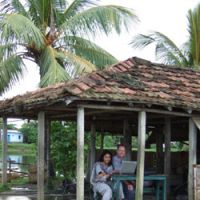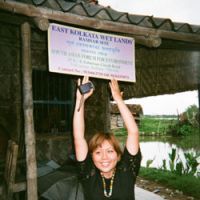Representatives of 158 nations will converge next week on Changwon in South Korea, where they will spend nine days, from Oct. 27 to Nov. 4, talking about how to save the world's wetlands.
When they are done, they will have spent fortunes on flights, accommodation, food and entertainment; but will they have ensured funding for critically important conservation projects in developing countries, where wetlands are being lost at an alarming rate?
I ask this because I recently toured one of these project sites, the East Kolkata Wetlands, located in southeastern Kolkata, India — formerly known as Calcutta. The so-called EK Wetlands and its advocates exemplify how a little money at the grassroots level can go a very long way — and do a world of good.
Ever since I met Dr. Dipayan Dey and Amrita Chatterjee last year, two environmentalists dedicated to conserving the EK Wetlands and surrounding communities (see this column, Sept. 2007), I have wanted to tour those wetlands, and last month I got the chance.
The wetlands comprise 12,500 hectares that have been channeled and developed by the local population over hundreds of years. They are presently home to tens of thousands of people and provide food and jobs for tens of thousands more. And they include 4,000 hectares of ponds that each day receive 780 million liters of metropolitan sewage that is purified as it passes through a series of settling ponds, oxidation basins and fish ponds. All of this at no cost to the city.
But Kolkata's policymakers are struggling with too many crushing pollution, population and development problems to be proactive about the wetlands, so Dey and Chatterjee are forced to seek funding anywhere they can, at home and abroad. Consequently, they are hoping that the delegates in South Korea will renew their efforts to find funding for projects in the developing world, where small financial change can bring about big environmental change.
South Korea is the venue for the 10th Conference of the Contracting Parties (COP) to the Ramsar Convention on Wetlands of International Importance. Known as the Ramsar Convention, because the treaty was adopted in 1971 in Ramsar, Iran, the agreement requires member nations to hold a COP every three years. The fifth COP was in Kushiro, on Japan's northernmost main island of Hokkaido.
The stated mission of Ramsar is "the conservation and wise use of all wetlands through local, regional and national actions and international cooperation, as a contribution toward achieving sustainable development throughout the world." Today scientists and policymakers understand even better the critical importance of wetlands, and as these issues have become more high profile, the treaty is now commonly referred to simply as the Ramsar Convention on Wetlands.
On paper, Ramsar is a good idea. It has 158 member states, which is not far behind the total number of United Nations member states, now 192. The "flagship" of the treaty is its "List of Wetlands of International Importance," also known as the "Ramsar List," which includes 1,801 sites covering 163,142,801 million hectares (1.63 million sq. km).
In those Ramsar nations that have sufficient funding and political will, these wetlands of importance are getting some protection. But in developing nations such as India, where wetlands conservation is not a priority, they are being listed, but pollution and uncontrolled development continue to pose serious threats to all wetlands, including Ramsar sites.
So what's so special about these places where the water and land meet?
"Wetlands provide fundamental ecological services and are regulators of water regimes and sources of biodiversity at all levels — species, genetic and ecosystem. They constitute a resource of great economic, scientific, cultural and recreational value for communities, and wetlands play a vital role in climate-change adaptation and mitigation," states the Ramsar Web site.
The meaning of "wetland" might seem self-evident, but the term covers a broad range of ecosystems.
The convention defines wetlands as: "Areas of marsh, fen, peatland or water, whether natural or artificial, permanent or temporary, with water that is static or flowing, fresh, brackish or salt, including areas of marine water the depth of which at low tide does not exceed six metres." (see www.ramsar.org )
But that's not all. the convention recognizes five major wetland types: marine (coastal wetlands, including coastal lagoons, rocky shores and coral reefs); estuarine (including deltas, tidal marshes and mangrove swamps); lacustrine (wetlands associated with lakes); riverine (wetlands along rivers and streams); and palustrine (meaning "marshy," i.e. marshes, swamps and bogs).
Ramsar wetlands also include "human-made wetlands such as fish and shrimp ponds, farm ponds, irrigated agricultural land, salt pans, reservoirs, gravel pits, sewage farms and canals," according to the Web site.
Wetlands are found everywhere, from Siberia to Sumatra, and the UNEP-World
Conservation Monitoring Centre estimates that about 570 million hectares (5.7 million sq. km), or about 6 percent of the Earth's land surface is wetland. Ramsar sources put the world's total wetlands area even higher. A survey done for the 1999 COP posits the "best" minimum global estimate at "between 748 and 778 million hectares" — and as high as 4,462 million hectares.
One mechanism to help developing countries conserve and implement "wise use" of wetland resources is the Ramsar Small Grants Fund (SGF), established in 1990. Between 1991 and 2006, the Swiss-based fund provided about 7 million Swiss francs (¥623 million) to 212 projects in 103 countries, granting up to 40,000 Swiss francs (¥3,560,000) per project.
Over the same period of time, however, 448 feasible projects were not supported due to lack of funds. SGF grants come solely from voluntary contributions of governments and national and international NGOs, and despite widespread recognition that wetlands are invaluable, the money just isn't there.
Each year, as part of the SGF program, the Ramsar Secretariat draws up a shortlist of projects at Ramsar wetland sites that are in urgent need of funding and have passed a rigorous evaluation procedure — one that evaluates the strength of the project and the capacity of the proponents to complete the project successfully.
In 2007, only 14 projects made the list: One was a proposal by Dey and Chatterjee on behalf of their organization, the South Asian Forum for Environment (SAFE), to strengthen and expand protection of the East Kolkata Wetlands. It never got funding.
The Ramsar delegates in South Korea should give this some serious thought: Here is a strong proposal rigorously evaluated; an NGO with the capacity for successful completion of a project that is impacting the lives of tens of thousands of Indians; the need for funding is urgent; and yet no government or organization has stepped up to provide a mere 40,000 Swiss francs (¥3,560,000) for SAFE and other projects on the 2007 SGF list.
Furthermore, the 2008 SGF list will come out soon, highlighting another batch of outstanding projects that are unlikely to receive funding.
Even more troublingly, the East Kolkata Wetlands could lose their Ramsar status due to urban encroachment and increasing pollutant loading just six years after being selected as a Ramsar site, according to Dey.
Nevertheless, Dey, Chatterjee and their colleagues continue to work seven days a week, tracking down funding, doing social and scientific research, and developing community programs, particularly for women in the area.
What makes this situation uniquely frustrating is watching governments throw billions of dollars at the world's hemorrhaging banking system, knowing that just a tiny fraction of that cash, if diverted to worthy grassroots projects, could ensure real progress in protecting the planet's essential ecosystems.
Instead, we spend billions to save the same institutions that have undermined ecosystems worldwide by providing financing for careless resource exploitation and haphazard development.
To put it another way, try to imagine an economic system without healthy ecosystems to depend on: You're right if the Moon or Mars come to mind.
So while the rich get richer, and bail themselves out of a pinch, the poor get on with trying to save the Earth — for all of us.
What a world.
For more information on SAFE's work, visit www.safeinch.org or e-mail SAFE at [email protected] Stephen Hesse welcomes readers' comments at [email protected]






